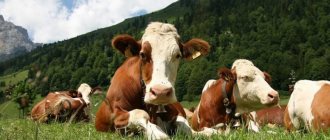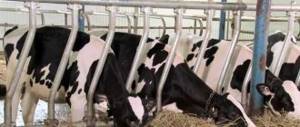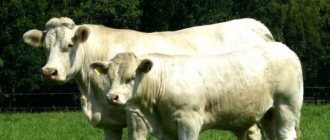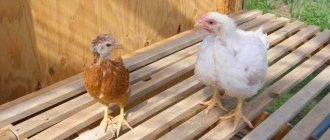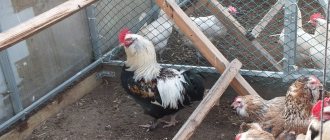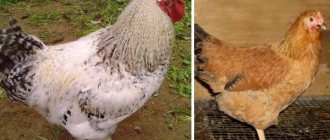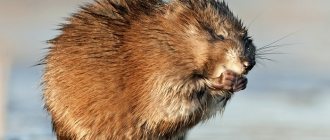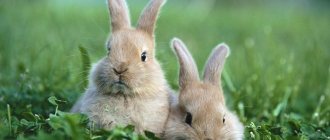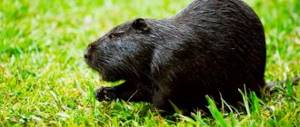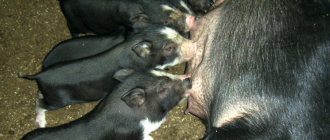Methods of keeping cattle
At the MTF base, cows are kept tied or loose. In many post-Soviet countries, the second method is more popular.
Anchor Content
With this method of keeping cows, they are placed on a leash in individual stalls with a feeder and drinking bowl, where almost all animal maintenance operations are carried out. Feed is distributed into feeders using mobile means or stationary feed dispensers.
In the stalls, cows are milked using milking buckets or into a milk line, and given water from automatic drinking cups.
Manure is removed by scraper conveyors. To organize exercise during the stall period, walking areas are equipped near the barn. The main advantages of tethered housing:
- individual care and maintenance of animals;
- rationed feeding;
- individual milking of fresh cows;
- effective control of launch timing, calving, etc.
Disadvantages of tethered housing:
- high labor costs for production;
- it is difficult to organize active exercise;
- difficulties associated with mechanization and individual dosage of concentrated feed.
At the same time, in advanced farms with tethered housing, the average annual milk yield is 5500-6000 kg of milk. At the same time, up to 6 people/hour are spent on 1 centner of products.
Loose Contents
With this system, group housing of animals is used.
Cows are not fixed. They always have access to food (with the exception of concentrates), drinking bowls, resting places and a walking area. One of the prerequisites is a sufficient amount of feed. Free-stall housing options:
- on deep litter;
- in boxes;
- combibox.
The first type of maintenance method is recommended if there is a large amount of straw. The main part of the room is a den intended for the animal to rest. The frequency of cleaning deep litter is once or twice annually. A walking area is used as a feeding area. The cattle are also fed indoors.
With this method of keeping, milking in milking parlors is widely used. Milking units:
- "Tandem";
- "Herringbone";
- "Carousel".
A relative innovation is milking by robots.
Advantages of keeping on deep litter:
- low labor costs;
- problems associated with exercise are eliminated;
- high-quality organic fertilizer is available - manure;
- high level of specialization and division of labor among livestock breeders.
Disadvantages of keeping on deep litter:
- high consumption of litter;
- excessive consumption of feed;
- insufficient individual control over animals, etc.
With free-stall housing, 50% of the area is boxes (resting areas), 50% is the feeding area. The minimum feeding front is 80 cm. Feed is distributed and manure is removed using copious amounts. And in this case, milking parlors are relevant.
The loose-stall housing method, as well as free-stall housing with rest on deep litter, is the most promising in dairy cattle breeding.
Combi-box housing differs from free-stall housing in that the cow is kept in a short box adjacent to the feeder, in which the animal rests and takes food. Combiboxes are placed in the same way as in a tied stall - along the stern line. Feed is distributed by mobile means, manure is removed by scrapers, and milking is carried out in milking parlors.
Combi-box housing allows for more economical use of livestock buildings, rationing of feeding and avoiding the distribution of concentrates at the milking area. By securing cows in boxes during feeding, the problem of oppression of weak and timid cows is eliminated, resting conditions are improved, and injuries to the udder and hooves are reduced. A significant disadvantage of combi-box housing is the higher (compared to separate boxes) contamination of the skin and poor quality of milk.
FARMERS SHOULD KNOW THAT THE TRANSITION FROM PASTURE TO STALL CONTENT IS A CRITICAL PERIOD IN DAIRY FARMING.
IT SHOULD ACTUALLY START FROM MIDDLE AUGUST, THAT IS, FROM THE MOMENT OF THE GRASS STOCK DECREASING IN THE PASTURES AND ITS QUALITY DECREASING.
At the end of summer, cows need to gradually increase the share of winter feed (hay, straw, root crops) by 10-15% of the requirement so that by the end of September the rations are fully consistent with the winter period. By this period, pasture and green feed in stalls are used as additional feeding during active cow walks.
You need to know that a sharp change in feed in the diet during the transition period causes a change in the rumen microflora in animals, leads to dysfunction of the digestive tract, a decrease in feed digestibility and cow productivity.
When reducing the use of grasses from pastures, vegetable waste can be introduced into the diet, but keep in mind that it contains a lot of moisture and little protein, fiber and minerals. Therefore, at the same time as adding succulent feed to the diet, the cow should also be given 3-4 kg of hay. This increases the energy value of the diet. To increase the fiber content, you can use good quality straw (better than spring crops).
Care should be taken to prepare feed for the winter. The main roughage forage on private farms is hay. The moisture content in it should not be higher than 15-20% (when compressed into a bundle, the hay rustles, makes a cracking sound and quickly breaks).
When placing moistened hay (the waste of perennial grasses) for permanent storage, it is sprinkled with salt at regular intervals (at the rate of 6-7 kg of table salt per 1 ton of hay). To preserve the high quality of hay longer, it is placed on pyramids or vents. It is advisable to cover the top of the stack with film and put “anemones” from poles.
Ensilage feed is usually not prepared on individual farms, but it could serve as cheap and complete feed for cows during the stall period. A cow can be fed up to 30-35 kg of good silage per day.
Good roughage for cows can be barn feed - straw and chaff (especially spring crops). They are inferior in nutritional value to hay, but are well eaten after appropriate preparation for feeding (grinding, steaming, flavoring with mixed feed, pulp, stillage, molasses). Chopped straw can be mixed with 25-30% finely chopped root vegetables and tubers.
Root and tuber vegetables, beets of various varieties, rutabaga, turnips, carrots, potato and pear tubers, pumpkin and zucchini fruits are distinguished by their high dietary properties, good palatability and digestibility. They contain 70-90% water, so they cannot be the only food for cows, but are a valuable part of the feed ration.
Root tubers can be stored in piles or cellars. A dairy cow is given up to 30 kg of root and tuber crops per day, and sugar beets and potatoes - up to 15 kg.
Grain feeds have a high concentration of nutrients, but their nutritional value increases by 25-30% if fed in the form of compound feed. The daily supply of compound feed to dairy cows is determined depending on milk yield (250-400 g per 1 liter of milk). For more efficient use of all feed in the diet, it is better to feed concentrated feed to cows fractionally, dividing the daily intake into 2-3 parts.
Preparing cows for winter housing should be carried out without disturbing the milking regime. If there was three-time milking in the summer, you cannot switch to two-time milking, since such a transition inevitably leads to a decrease in productivity, and often to self-breeding of cows.
And one last thing. It is necessary to carefully prepare the premises for wintering livestock. It must be repaired and insulated, spacious enough, light and dry, and have ventilation. It is better to make feeders hanging. Windows must open, and they should be located behind or to the side of the animal so that the cold air cools the animal less and the sunlight does not “hit” its eyes.
It is advisable to make the floor wooden, always with a slight slope (1-2 cm per 1 m) from the feeder to the manure pan.
If you keep a cow incorrectly and do not maintain the temperature in the room, especially in winter, then a significant part of the feed will be consumed by the animal for self-warming. The optimal temperature for keeping livestock in winter is 8-15°C; lowering it causes a significant overconsumption of feed, and raising it leads to a depressed state and a decrease in productivity.
Cows are given daily exercise for at least 2-3 hours a day. At this time, the room is ventilated.
However, when the air temperature is below minus 20°C, as well as in rainy weather, ice or blizzards, the walk should be cancelled. Stop walking 2-3 days before calving. After calving, a healthy cow is allowed out for a walk only for 2-3 days. For walks, you can use a small paddock equipped next to the barn.
It is important to strictly observe the daily routine, at the same time to feed, milk, water, clean the cow, and let her out for a walk. Any disruption to the daily routine causes a decrease in productivity.
When feeding a cow, you cannot give the entire daily amount of roughage at once, since, when receiving a large volume of feed, the cow begins to sort through it, and when wetted with saliva, the feed acquires an odor that is not characteristic of it, after which the animal eats it reluctantly. To avoid this, it is better to divide the portion of roughage into 2 or 3 cottages.
For fresh cows, it is advisable to introduce 4-fold feeding in order to identify their maximum productivity. Cows should not be fed before milking, as some feeds leave an odor that transfers to the milk.
When feeding 3 times, it is better to distribute grain and succulent food in the morning and at noon, and roughage at each feeding.
The following order of feeding is desirable: concentrated feed is given first, then succulent feed, and lastly roughage.
Residues of feed from the feeders must be removed, as they rot and the putrid odor is transferred to other feeds. It is better to water the animals after distributing succulent food; the water temperature should not be lower than 10-12°C. It is better to prepare water for drinking a cow in a vat placed in the room where it is kept so that the water is at room temperature. The cow needs to be given plenty of water; the number of waterings should correspond to the number of feedings.
As bedding for animals, 1.5-3 kg of straw or dry leaves, 1-3 kg of peat, 2-5 kg of sawdust per day are usually used. Good bedding quickly absorbs moisture and absorbs harmful gases, thereby protecting the animal from colds, skin and respiratory diseases.
Manure is regularly removed from the premises and placed in heaps in a specially designated place on the plot. The use of straw and leaves as bedding increases the quality of manure as a fertilizer, and the use of sawdust somewhat reduces it.
Proper feeding and maintenance of cows during the transition and stall periods is the key to good health and high productivity.
N.T. MIKHEDOV. https://honeygarden.ru.
Dry cows
Nutritional value of the diet after starting a cow, in% of the average norm for decades:
- I – 80%
- II – 100%;
- III and IV – up to 120%.
In the last decade, the nutritional value of the diet decreases to 70-80%. This is done to cleanse the gastrointestinal tract before calving.
Diets include only high-quality feed. In the total amount of roughage, hay should make up at least half of its weight, concentrates - 20-25% of the total nutritional value, fiber content in the diet - 25-30% of the dry matter of the feed.
Dry cows should be separated into separate groups and kept off-leash, resting on deep bedding or in boxes. During the stall period, it is necessary to provide for the exercise of pregnant animals. It should be daily, except for rainy days, at least 2-3 hours a day. It stops ten days before replenishment in the herd.
Bedding material
When transferring cows to winter housing, their availability of bedding material is taken into account. Dry rye straw, peat, wood shavings and sawdust are used as bedding in winter. In addition, spruce branches or dry tree leaves can be good bedding material.
Straw bedding is considered the best and requires about 2.5 kilograms per animal per day. Chopped straw with lengths up to 25 centimeters has the best qualities. In this form, it is more hygroscopic, absorbs slurry much better, and in addition, such straw is easier to remove.
Read also: TOP 7 breeds of dairy cows
Peat, as a bedding material, is very hygroscopic, absorbs moisture well, and is best used in conjunction with straw. Its supply should be within 2-3 kilograms per day per animal.
Sawdust, in order to sufficiently provide animals with bedding material, should be stored within 3-5 kilograms per animal per day. Dry leaves are equivalent in quality to sawdust; spruce leaves, having a low absorption capacity, are used less frequently, and their supply should be significantly larger.
Cash cows
For two days, calved animals are fed good hay and bran (up to 1.5 kg/head). Instead of bran, you can give oatmeal. If the cows' udders are not inflamed, then the amount of silage, fodder beet, and, in the summer, pasture feed is gradually increased in the diet. Maximum by the tenth and minimum by the seventh day, the diet is brought to normal. At the same time, the supply of concentrated feed increases.
To obtain high milk yields, on the 14-15th day after calving, milking of cows begins, but on the condition that the mammary gland of the calving cow has fully recovered.
Milk production covers the first 90-100 days of lactation. At this time, the animal is fed in advance (while the daily milk yield increases), that is, the feeding rate is increased daily by two to three feed units. A prerequisite is active exercise. The amount of feed fed is determined by several factors, including:
- actual milk yield;
- in advance.
If control milking does not show an increase, advanced feeding is stopped.
After the cows are milked to maximum milk yield, their feeding is brought into line with the norm. In order to maintain the level of milk yield achieved during milking for as long as possible without a sharp decrease, the main attention is paid to the completeness of the diet. An unbalanced diet in terms of energy and basic nutrients leads to a rapid decrease in milk yield. During the stall period, dairy cows can be kept either on a leash or without it. Optimal microclimate parameters must be maintained in the premises.
Proper feeding of livestock in winter is of great importance
Cattle and small cattle, as well as horses, are kept on farm pastures during the transition period. The only exception is newborn young animals. To maintain the fatness of animals, they are fed green mass and commercial feed. The diet of animals in winter depends on their species, gender and even age, as well as some other factors. For the transition period, rapeseed will be the best forage crop. Sowing rapeseed for the autumn period is done with the following calculation: one ton of green mass per cow or one hectare per ten cows. Feed that is prepared for the winter period should be offered to animals in advance so that there is no sudden change. Animals must get used to being fed silage or hay. Over two to three weeks, the norm should gradually increase. In other words, winter animal feed is introduced at the beginning of September, but in small quantities. Hay is offered in the barnyards before milking in the morning and evening. This will increase the animal's appetite throughout the day. On the first day, silage is given, starting from three to five kilograms per head. It is given early in the morning before milking and before the animals go out for grazing during the day.
Preparing the premises for wintering
Scientists have long established that the lower optimum zone for this representative of domesticated fauna lies at the level of -10°C. Although, unfortunately, many farms still use so-called “cold” barns, the temperature regime of which is not much different from external conditions.
Read also: Is it possible to give salt to rabbits?
We have already figured out where your herd will winter. The next point concerns how they will do this.
The water supply must be protected from frost
A big difficulty during frosts is a guaranteed water supply. But here, in most cases, a good solution is to insulate the drinking system or heated drinking bowl. Another option is a constantly working well. For ball drinkers, there is a great danger that the ball on the rim of the drinker may freeze. The water inside will not freeze. In such cases, as a rule, it is enough to knock on the ball.
The pipeline itself poses more difficulties than the desoldering system. But if it is insulated, heated, or constant water circulation is maintained in it, there will be no problems with freezing. The water supply should, if possible, be laid at a depth where the soil does not freeze.
Read also: Why does a cow have no chewing gum and what to do in this case
